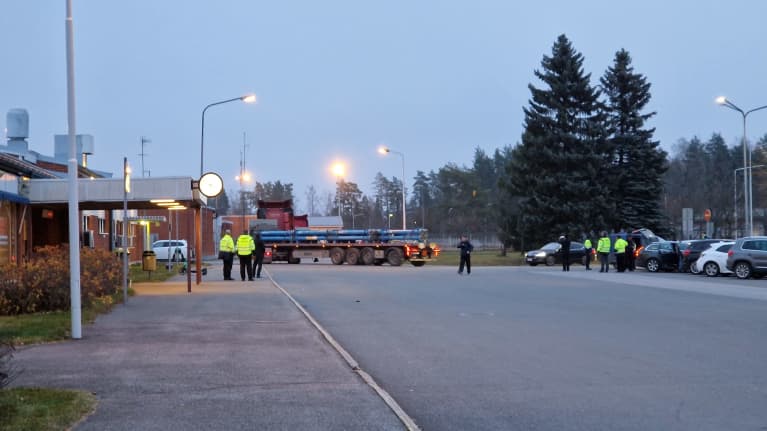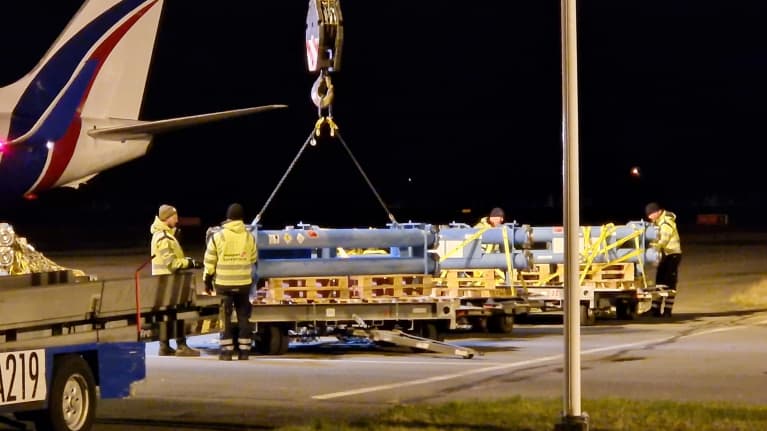Police and other authorities were out in force at Lappeenranta airport in eastern Finland on Saturday evening due to a transit delivery of Russian nuclear fuel.
The fuel was bound for another EU member state, Slovakia. Nuclear fuel is not subject to EU sanctions.
Two lorries arrived at Lappeenranta airport with a police convoy in the early evening. The vehicles were loaded with long pipes marked with radiation hazard symbols.
The airport is less than 30km from Lappeenranta's Nuijamaa border crossing point.
Police from all over southeast Finland
An Yle reporter on the scene saw personnel from the Radiation and Nuclear Safety Authority (Stuk), staff from energy utility Fortum's Loviisa nuclear power plant and many police officers from all over southeast Finland.
Around 7pm, airport crews began loading them onto two Swiftair cargo planes bound for Bratislava, Slovakia, according to the Flightradar24 website.
By 9pm, the loading was still in progress, although according to Flightradar24, the planes' scheduled time of departure was 5pm. One was shown as taking off just before 10pm and landing in Bratislava around 11:30pm, while no details were listed for the second plane.
Stuk: "Transit not exceptional"
Staff from the majority-state-owned Fortum was on hand to help supervise the operation, but the company said it was not related to the Loviisa nuclear power plant on Finland's southeast coast.
"The cargo has nothing to do with the operation or production of the Loviisa plant. And we can also confirm that it is not nuclear waste," Fortum Senior Communications Manager Mark Autio told Yle. He declined to provide more details, citing confidentiality.
Stuk Director General Petteri Tiippana confirmed that the fuel came from Russia.
"Transporting unused fuel through Finland is a very well-established activity," he said, adding that fuel is delivered to Finnish nuclear plants "a few times a year".
"Transits are perhaps less frequent, but it is not an exceptional activity," he said. According to Tiippana, the transport was not related to any Finnish nuclear power plant.
Tiippana explained that Stuk checked the plan for the transport in question and the related security plans last summer.
"We concluded that they were appropriate and permission for the transport was given," said the watchdog director.
He also confirmed that Fortum and the police played a role in securing the transport.
Article continues after photo

"When this kind of transport takes place, security personnel are needed. In this case, the (nuclear fuel) driver ordered the security for the transport through Fortum," said Tiippana.
Police seek public help in drone probe
On Sunday, the Southeastern Finland Police Department asked for tips from the public about a drone seen operating in a no-fly zone at the airport on Saturday afternoon.
The drone sighting was made "at approximately the same time" as the fuel-loading operation, said Detective Sergeant Ilkka Vainikka, who added that the device may have caused "an unnecessary, possibly dangerous situation".
There were plenty of police officers at the airport to monitor the fuel transport, but the drone was not brought down.
"These decisions are always made on a case-by-case basis," said Vainikka.
As of Sunday afternoon, police had not yet identified the drone pilot but had launched a preliminary investigating into the incident as an aviation violation. The pilot could face a hefty fine.
The police ask that anyone with information about the incident to contact them by email at vihjeet.kaakkoi-suomi@poliisi.fi or by phone at 0295414559.
Loviisa plant still Russian-fuelled
Last March, a plane carrying fuel for two Slovak nuclear power plants landed in Slovakia despite the country’s airspace being closed to Russian planes, reported Euractiv. It said that Slovakia has six nuclear reactors in operation, with two more under construction. All of them use fuel from the Russian firm TVEL, a subsidiary of the Kremlin-controlled nuclear power giant Rosatom. Slovakia has a contract with TVEL that runs until 2026.
Fortum also acquires the Russian fuel used by the Loviisa nuclear power plant from TVEL. The plant's two Soviet-designed reactors date back to 1977 and 1981.
Last spring, Fortum said that a quick change of fuel supplier was not possible. Its supply contracts are valid until 2027 and 2030.
However Fortum announced that it would stop new investments and funding of Russian subsidiaries. Fortum no longer procures coal, pellets or biofuel from Russia for its power plants in Finland.
A day after the Russian invasion of Ukraine began in February, Finland's Minister of Economic Affairs Mika Lintilä (Cen) in effect cancelled a planned nuclear plant in northern Finland that was to have been built and supplied by Rosatom. In 2015, Fortum reluctantly stepped in to rescue the project after the controversial deal with Rosatom was announced.
17.45: Updated with drone investigation.
